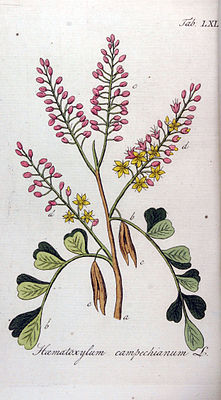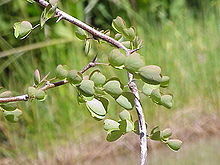Bloodwood tree
| Bloodwood tree | ||||||||||||
|---|---|---|---|---|---|---|---|---|---|---|---|---|

Bloodwood tree ( Haematoxylum campechianum ), illustration |
||||||||||||
| Systematics | ||||||||||||
|
||||||||||||
| Scientific name | ||||||||||||
| Haematoxylum campechianum | ||||||||||||
| L. |
The Bloodwood Tree ( Haematoxylum campechianum ), and blue wood tree or Campechebaum (because he in the south of the state of Campeche in Mexico originated has), is a plant that to the subfamily of caesalpinioideae (Caesalpinioideae) within the family of legumes belongs (Fabaceae). It is native to Central America and the northern part of South America, as well as to Caribbean islands. He supplies the logwood or bloodwood ( campech wood , Latin Lignum campechianum , French bois bleu , Bois de campêche or Bois d'Inde, English logwood , peach wood and blackwood ), the most important of all colored woods . In many tropical countries this species is an invasive plant . It used to be called blackwood to be used clandestinely.
description
Appearance, wood, bark and leaf
The bloodwood tree grows as an evergreen tree or shrub and reaches stature heights of about 10 meters or higher. It often has thorns up to 1.5 centimeters long and a red heartwood , hence the botanical genus name and the German common name blood wood tree . The scaly, relatively smooth bark is light gray to brown. The largely bare bark of the branches has many conspicuous, small, whitish lenticels .
The alternate leaves or leaves standing together in small clusters are about 1 centimeter long and stalked up to 10 centimeters long. The leaf blade is pinnate in pairs. There are 1 to 6 pairs pinna flake available. The smooth, shiny and short-stalked leaflets are up to 3.5 centimeters long and up to 3 centimeters wide and obovate to heart-shaped. The pinnate leaf nerve runs obliquely forward. Or sometimes the leaves in the lower area are doubly pinnate. They have up to 3 pairs of leaflets with up to 5 pairs of leaflets, the small leaflets are up to 1 centimeter long. There are small, often thorny stipules.
Inflorescence and flower
The mostly axillary on a short inflorescence stem, racemose inflorescences are up to 10-20 centimeters long and contain many flowers close together.
The fragrant, hermaphrodite and stalked flowers are radial symmetry and five-fold with a double flower envelope. The flower stalk has a length of 4 to 6 millimeters. The flower cup is small and funnel-shaped. The five reddish to yellow, free sepals are elongated-lanceolate with a length of 5 to 7 millimeters with a pointed upper end. The corolla has a diameter of 12 to 16 millimeters. The five yellow, free petals are 7 to 10 millimeters long and narrow, obovate to oblong with a blunt upper end. The ten, free, identical stamens are about the same length as the petals. The stamens are woolly hairy at their base. The uni-, elongated and shortly stalked, slightly hairy ovary is medium ever, the long and thin stylus ends in a small capitate stigma .
Fruit and seeds
The papery, thin legumes are 3 to 5.5 centimeters long and 1 to 1.5 centimeters wide, elliptical to oblong and contain one to three seeds. The fruit skin is thin and finely veined. The light brown, flat seeds are slightly kinked, kidney-shaped and elongated, with a length of up to 10-12 millimeters and a diameter of up to 3-5 millimeters.
Chromosome number
The number of chromosomes is 2n = 24.
use
At the end of the 19th century, logwood began to be cultivated in the Dutch colonies in East India . The large blocks freed from the whitish sapwood had a dark blood-red to brown-red color on the outside, inside they were lighter, reddish-brown to yellowish-brown, gradually becoming dark red-brown in the air. The wood is hard and dense, difficult to split, has a faint, vaguely violet-like odor and has an astringent effect .
A distinction is made between the Mexican Campeche wood or Laguna Campeche, Jamaica blue wood and Domingo blue wood; There are several types of the latter, such as Monte Cristo, Fort Liberte and Aux Cayes blue wood. Martinique and Guadeloupe logs are considered to be of lower quality.
The substance of the log, which determines the staining power and is widely used in histological technology, is hematoxylin ; In its purest state it forms almost colorless crystals, which, however, soon become reddish in the air and finally turn into the actual dye , the hematein . Because there is only a small amount of this dye in the freshly shredded blue wood, the chips are left to ferment in the air , whereby they develop the desired color; the chips of better quality then show a peculiar metallic yellowish-green sheen.
The blue wood extract prepared from the log was also an important commercial item; it was imported to Europe in solid form via New York in boxes of 50 to 100 kg. The log was used in dyeing and ink manufacture , sometimes also in medicine, and as timber.
Bluewood can be used for dyeing wool, cotton, linen and silk , wild silk. Depending on the added metal salt, different colors can be achieved.
The reddish, hard and very heavy, durable but brittle wood is called blood or blue wood and is mostly used for coarser constructions, but it can also be used in cabinet making. The wood has a pleasant smell of violets.
Taxonomy
The first publication of Haematoxylum campechianum was made in 1753 by Carl Linnaeus in Species Plantarum , 1, p 384. A synonym of Haematoxylum campechianum L. Cymbosepalum baronii Baker.
literature
- Syed Irtifaq Ali: Caesalpiniaceae. : Haematoxylum campechianum at Tropicos.org. In: Flora of Pakistan . Missouri Botanical Garden, St. Louis, Volume 54.
- JH Ross: Haematoxylum campechianum in the Flora of Australia online .
- Stephan Imhof: Useful plants data sheet - Haematoxylum campechianum .
- E. Gagnon, A. Bruneau, CE Hughes, LP de Queiroz, GP Lewis: A new generic system for the pantropical Caesalpinia group (Leguminosae). In: PhytoKeys. 71, 2016, 1–160, on p. 34 f, doi: 10.3897 / phytokeys.71.9203 , online (PDF; 44 MB), at ZORA (Zurich Open Repository and Archive), University of Zurich.
Web links
- Haematoxylum campechianum from PROTA, accessed on October 14, 2018.
- Data sheet from T. Seilnacht .
- Haematoxylum campechianum from Useful Tropical Plants, accessed October 14, 2018.
- Blauholz at materialarchiv.ch, accessed on November 23, 2018.
Individual evidence
- ^ Wilhelm Hoffmann : General Encyclopedia for Merchants, Manufacturers,…. 7th edition, first volume: A – G , Wiegand, 1847, p. 414.
- ^ E. Gagnon, A. Bruneau, CE Hughes et al .: A new generic system for the pantropical Caesalpinia group (Leguminosae). In: PhytoKeys. 71, 2016, pp. 1–160, doi: 10.3897 / phytokeys.71.9203 .
- ↑ First publication scanned at biodiversitylibrary.org .
- ^ Haematoxylum campechianum at Tropicos.org. Missouri Botanical Garden, St. Louis





